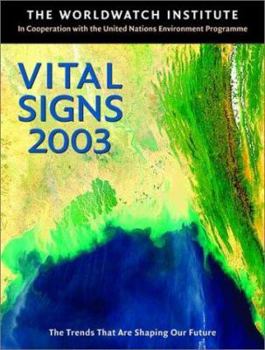Vital Signs 2003: The Trends That Are Shaping Our Future
This report presents and explains statistics that reflect the world's progress toward ecologically sustainable development and a more equitable global distribution of resources, shedding light on recent trends in areas such as AIDS treatment, war and armed conflict, the gap between rich and poor nat
Format:Paperback
Language:English
ISBN:0393324400
ISBN13:9780393324402
Release Date:May 2003
Publisher:W. W. Norton & Company
Length:153 Pages
Weight:0.58 lbs.
Dimensions:0.5" x 6.9" x 9.2"
Customer Reviews
1 rating
A wealth of reliable information
Published by Thriftbooks.com User , 20 years ago
This volume, prepared on an annual basis by the World Watch Institute in cooperation with the UN Environment Program, helps the reader to grasp the big picture by identifying important trends shaping our future and progress towards ecologically sustainable development. It provides a snapshot of the world and is a respected source of facts and figures. "The year 2002 set numerous local and regional records for windstorms, rain intensities, floods, droughts, and temperatures. Economic losses from weather disasters worldwide approached $53 billion, a 93% increase over 2001 losses. The increase was due in part to the return of El Nino in mid-2002. The number of natural disasters totaled about 700; of these 593 were weather-related events. Windstorms and floods accounted for 98% of total 2002 insured losses from natural catastrophes." Many of the problems arise because of the gap between the rich and the poor - the wealthy impose the heaviest toll through their materials-intensive, pollution-laden lifestyles while the poor live in the worst conditions and over tax cropland, forests, and water resources. Experts and activists are putting forward proposals, expressed at government level by the Millenium Goals and the Plan of Implementation declared at the 2002 World Summit on Sustainable Development, to meet the major challenge of our times - improving the lifestyle of billions of people without wrecking the delicate balance that sustains all life on the planet. While a minority enjoys plentiful food, mobility and cutting edge technology, a large majority worries about daily survival. Hunger is widespread, not because of a shortage of food, but because many lack money to buy grain used to fatten livestock so the wealthy can eat meat. Deep disparities between rich and poor is found between countries but also within countries. The growing economic divide translates into unequal educational opportunities, unfunded social programs, vulnerability to disease and natural disasters, and exposure to armed conflict and human rights violations. The first key indicator is in food trends where grain production is dropping at the same time as meat consumption is growing. The second key indicator is in energy and atmosphere trends. "Measurements taken at Mauna Loa Observatory in Hawaii show an 18% increase in CO2 levels from 1960 to 2002. Scientists estimate that levels have risen 31% since the onset of the Industrial Revolution around 1750. The current concentration has not been exceeded in at least 420,000 years - and likely in 20 million years. In May 2002, ocean buoys in the central Pacific started reading warmer-than-average temperatures, heralding the onset of El Nino, which persisted into 2003, sharply changing patterns of rainfall, temperature and winds in some regions and contributing to, for instance, droughts in India, Australia, and Africa and floods in Europe. Scientists believe that this El Nino may help push the global temperature to a new high in 2003.





